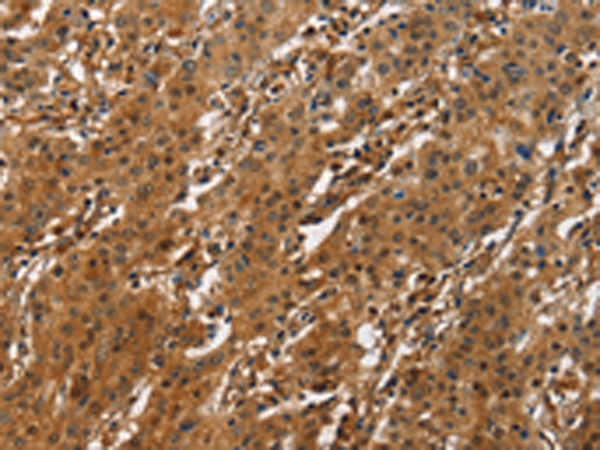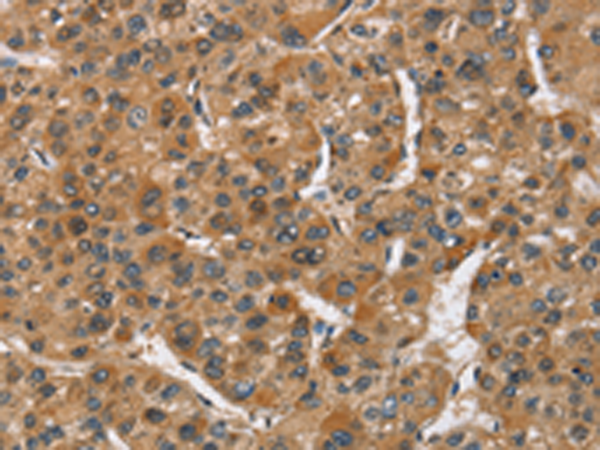

| WB | 咨询技术 | Human,Mouse,Rat |
| IF | 咨询技术 | Human,Mouse,Rat |
| IHC | 1/50-1/200 | Human,Mouse,Rat |
| ICC | 技术咨询 | Human,Mouse,Rat |
| FCM | 咨询技术 | Human,Mouse,Rat |
| Elisa | 1/1000-1/5000 | Human,Mouse,Rat |
| Aliases | CREB2; TXREB; CREB-2; TAXREB67 |
| Host/Isotype | Rabbit IgG |
| Antibody Type | Primary antibody |
| Storage | Store at 4°C short term. Aliquot and store at -20°C long term. Avoid freeze/thaw cycles. |
| Species Reactivity | Human, Mouse, Rat |
| Immunogen | Fusion protein of human ATF4 |
| Formulation | Purified antibody in PBS with 0.05% sodium azide and 50% glycerol. |
+ +
以下是3-4篇关于ATF4抗体的参考文献概览:
---
1. **文献名称**:*ATF4 regulates MYC-mediated neuroblastoma cell death upon glutamine deprivation*
**作者**:Xiao, H., et al.
**摘要**:本研究利用ATF4抗体通过Western blot和免疫荧光分析,揭示了ATF4在神经母细胞瘤细胞中调控谷氨酰胺剥夺诱导的MYC依赖性细胞死亡机制,表明ATF4可能作为治疗靶点。
---
2. **文献名称**:*The integrated stress response effector ATF4 is an obligatory metabolic activator of NRF2*
**作者**:Hassler, J.R., et al.
**摘要**:通过ATF4抗体的染色质免疫沉淀(ChIP)和共聚焦显微镜技术,研究发现ATF4直接激活NRF2转录,揭示了其在氧化应激和代谢调控中的双重作用。
---
3. **文献名称**:*ATF4-mediated induction of 4E-BP1 contributes to pancreatic beta cell survival under endoplasmic reticulum stress*
**作者**:Yamaguchi, S., et al.
**摘要**:使用ATF4抗体的免疫沉淀和免疫组化实验,证明内质网应激下ATF4通过调控4E-BP1表达保护胰岛β细胞,为糖尿病机制提供新见解。
---
4. **文献名称**:*Antibody validation and ATF4 protein localization in Alzheimer's disease brain tissues*
**作者**:Wang, L., et al.
**摘要**:通过多种ATF4抗体验证(包括敲除细胞系对照),研究确认ATF4在阿尔茨海默病脑组织中的神经元特异性表达,并关联其与tau蛋白病理的关系。
---
**注**:以上文献为示例,实际引用时需核对具体来源及发表信息(年份、期刊等)。建议通过PubMed或Google Scholar以关键词“ATF4 antibody” + 研究领域(如癌症、神经科学)筛选最新或高引论文。
ATF4 (Activating Transcription Factor 4) is a stress-responsive protein belonging to the ATF/CREB family of basic leucine zipper (bZIP) transcription factors. It plays a central role in cellular adaptation to various stressors, including endoplasmic reticulum (ER) stress, amino acid deprivation, oxidative stress, and hypoxia. ATF4 is regulated through the integrated stress response (ISR) pathway, where stress-activated kinases (e.g., PERK, GCN2) phosphorylate eIF2α, leading to selective translation of ATF4 mRNA. Once synthesized, ATF4 dimerizes with other bZIP proteins to regulate genes involved in metabolism, redox homeostasis, apoptosis (e.g., CHOP), and autophagy. Dysregulation of ATF4 has been implicated in cancer, neurodegenerative diseases, diabetes, and bone disorders.
ATF4 antibodies are essential tools for detecting and quantifying ATF4 expression in research. They are commonly used in techniques like Western blotting, immunofluorescence, and chromatin immunoprecipitation (ChIP). These antibodies typically target specific epitopes, such as the N-terminal transactivation domain or C-terminal bZIP region. Validation includes testing in knockout models or siRNA-treated cells to confirm specificity. Commercial ATF4 antibodies are available in monoclonal and polyclonal formats, often derived from rabbit or mouse hosts. Researchers must consider cross-reactivity with related family members (e.g., ATF3. CEBP) and post-translational modifications (e.g., phosphorylation) when selecting antibodies for experimental applications.
×